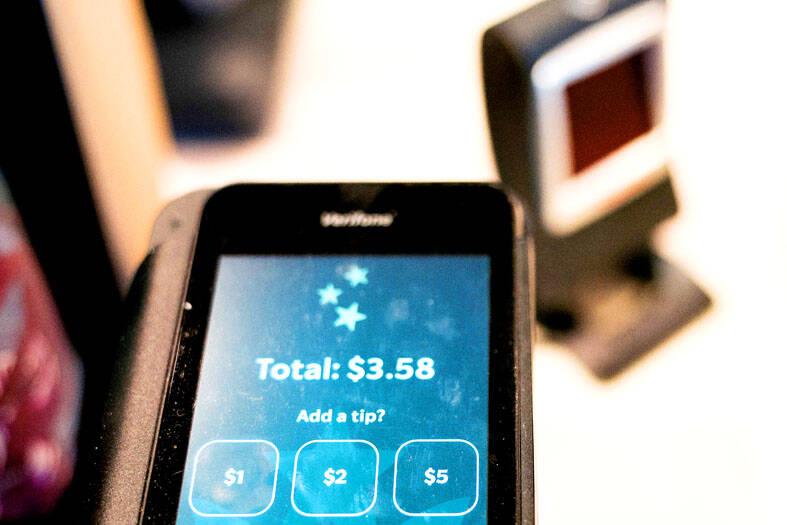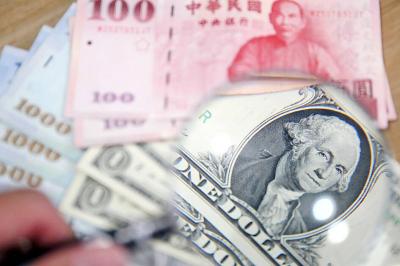To tip, or not to tip? That is the question many Americans are grappling with in a country where the tip is king — but even at a grocery store or for a bunch of flowers?
“Either way, you feel guilty,” said Matt Schottland, 41, in downtown Washington, a salad and a fruit juice in hand.
In the US, tipping is not a matter of debate in restaurants. A gratuity of about 15 to 20 percent of the value of a meal is a must, as it often makes up the bulk of the waiter’s salary.

Photo: AFP
What about for a sandwich to go? For Schottland, outside of restaurants, the answer is generally no, unless the employees are “super nice,” or he is feeling particularly generous, he said.
No solution is perfect.
If he tips, he might feel “guilty in some way or annoyed or resentful” for spending more money, and if he does not leave anything, he feels “guilty” toward the employees, he said.
“It’s not a great system,” he said.
The dilemma is relatively new. Tipping is spreading into more and more walks of life, making bills heftier in businesses where it was never expected before.
In response, experts warn of the risk of “tip fatigue,” a scenario in which Americans, overworked and hit by inflation, would no longer know where to tip, or how much.
That phenomenon is in turn likely to open up debate on the increasingly criticized system of remuneration in the hospitality industry.
Dipayan Biswas, professor of marketing at the University of South Florida, said that this expansion is largely due to “digital kiosks,” the electronic checkouts that have become ubiquitous in the past few years.
On these screens, on which customers pay their bill, companies can add a lot of options, including tips. To not cough up, the customer must deliberately click on the “no tip” button.
“That makes a lot of people uncomfortable. They don’t want to do that,” Biswas said. “Companies utilize the guilt factor.”
The strategy works on Hannah Koban, 30, who said that she does “tip a lot more than I used to.”
The continual request for a gratuity for the server “does feel like a little bit more pressure,” the lawyer said.
Digital kiosks sometimes suggest amounts of up to 30 percent of the total, well beyond the usual rate.
As a result, “trying to figure out like, when to tip, when not to tip, what is the appropriate tip, is it like always 20 percent now? I don’t know, and so I feel like I’m googling constantly when I should be tipping,” Koban said.
She said that while she might smile at the whole thing, she has “friends who are quite upset.”
Biswas said he fears that if Americans feel they have to tip everyone, there will be less for those who really need it the most, such as restaurant waiting staff.
Saru Jayaraman — president of the One Fair Wage association, which defends a “fair” salary for waiters — said that to speak of tip fatigue is “missing the point.”
“If we’re sick of continuously tipping, then join the movement to end the subminimum wage for tipped workers,” she said.
The COVID-19 pandemic, by reducing the number of times people were eating out, exposed the fragility of the remuneration system for waiters, in which their bosses pay less than the legal minimum wage. While Americans have since then returned to restaurants, the sector — known for its stressful working conditions — is still struggling to recruit.
The industry is undergoing “a revolution” because its employees are “resigning en masse,” Jayaraman said.
“Workers are saying: ‘I just won’t do it anymore,’” she said.
Things are changing. The US capital, Washington, in November last year joined a number of states in imposing a minimum wage, even for employees who are paid with tips.
“As long as there is a subminimum wage that exists for some, other industries are going to want to get the same free labor the restaurant industry has access to,” Jayaraman said.

The US dollar was trading at NT$29.7 at 10am today on the Taipei Foreign Exchange, as the New Taiwan dollar gained NT$1.364 from the previous close last week. The NT dollar continued to rise today, after surging 3.07 percent on Friday. After opening at NT$30.91, the NT dollar gained more than NT$1 in just 15 minutes, briefly passing the NT$30 mark. Before the US Department of the Treasury's semi-annual currency report came out, expectations that the NT dollar would keep rising were already building. The NT dollar on Friday closed at NT$31.064, up by NT$0.953 — a 3.07 percent single-day gain. Today,

‘SHORT TERM’: The local currency would likely remain strong in the near term, driven by anticipated US trade pressure, capital inflows and expectations of a US Fed rate cut The US dollar is expected to fall below NT$30 in the near term, as traders anticipate increased pressure from Washington for Taiwan to allow the New Taiwan dollar to appreciate, Cathay United Bank (國泰世華銀行) chief economist Lin Chi-chao (林啟超) said. Following a sharp drop in the greenback against the NT dollar on Friday, Lin told the Central News Agency that the local currency is likely to remain strong in the short term, driven in part by market psychology surrounding anticipated US policy pressure. On Friday, the US dollar fell NT$0.953, or 3.07 percent, closing at NT$31.064 — its lowest level since Jan.

The New Taiwan dollar and Taiwanese stocks surged on signs that trade tensions between the world’s top two economies might start easing and as US tech earnings boosted the outlook of the nation’s semiconductor exports. The NT dollar strengthened as much as 3.8 percent versus the US dollar to 30.815, the biggest intraday gain since January 2011, closing at NT$31.064. The benchmark TAIEX jumped 2.73 percent to outperform the region’s equity gauges. Outlook for global trade improved after China said it is assessing possible trade talks with the US, providing a boost for the nation’s currency and shares. As the NT dollar

The Financial Supervisory Commission (FSC) yesterday met with some of the nation’s largest insurance companies as a skyrocketing New Taiwan dollar piles pressure on their hundreds of billions of dollars in US bond investments. The commission has asked some life insurance firms, among the biggest Asian holders of US debt, to discuss how the rapidly strengthening NT dollar has impacted their operations, people familiar with the matter said. The meeting took place as the NT dollar jumped as much as 5 percent yesterday, its biggest intraday gain in more than three decades. The local currency surged as exporters rushed to